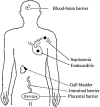Biotechnological applications of Listeria's sophisticated infection strategies
- PMID: 21261856
- PMCID: PMC3815243
- DOI: 10.1111/j.1751-7915.2008.00037.x
Biotechnological applications of Listeria's sophisticated infection strategies
Erratum in
- Microb Biotechnol. 2011 Sep;4(5):685-6
Abstract
Listeria monocytogenes is a Gram-positive bacterium that is able to survive both in the environment and to invade and multiply within eukaryotic cells. Currently L. monocytogenes represents one of the most well-studied and characterized microorganisms in bacterial pathogenesis. A hallmark of L. monocytogenes virulence is its ability to breach bodily barriers such as the intestinal epithelium, the blood-brain barrier as well as the placental barrier to cause severe systemic disease. Curiously, this theme is repeated at the level of the interaction between the individual cell and the bacterium where its virulence factors contribute to the ability of the bacteria to breach cellular barriers. L. monocytogenes is a model to study metabolic requirements of bacteria growing in an intracellular environment, modulation of signalling pathways in the infected cell and interactions with cellular defences involving innate and adaptive immunity. Technical advances such as the creation of LISTERIA-susceptible mouse strains, had added interest in the study of the natural pathogenesis of the disease via oral infection. The use of attenuated strains of L. monocytogenes as vaccines has gained considerable interest because they can be used to express heterologous antigens as well as to somatically deliver recombinant DNA to eukaryotic cells. A novel vaccine concept, the use of non-viable but metabolically active bacteria to induced immunoprotective responses, has been developed with L. monocytogenes. In this mini-review, we review the strategies used by L. monocytogenes to subvert the cellular functions at different stages of the infection cycle in the host and examine how these properties are being exploited in biotechnological and clinical applications.
© 2008 The Authors. Journal compilation © 2008 Society for Applied Microbiology and Blackwell Publishing Ltd.
Figures


Similar articles
-
Listeria pathogenesis and molecular virulence determinants.Clin Microbiol Rev. 2001 Jul;14(3):584-640. doi: 10.1128/CMR.14.3.584-640.2001. Clin Microbiol Rev. 2001. PMID: 11432815 Free PMC article. Review.
-
Tailoring host immune responses to Listeria by manipulation of virulence genes -- the interface between innate and acquired immunity.FEMS Immunol Med Microbiol. 2003 Apr 1;35(3):243-53. doi: 10.1016/S0928-8244(02)00469-8. FEMS Immunol Med Microbiol. 2003. PMID: 12648843
-
Listeriology (1926-2007): the rise of a model pathogen.Microbes Infect. 2007 Aug;9(10):1143-6. doi: 10.1016/j.micinf.2007.05.001. Epub 2007 May 6. Microbes Infect. 2007. PMID: 17618157 Review.
-
Classes and functions of Listeria monocytogenes surface proteins.Pol J Microbiol. 2004;53(2):75-88. Pol J Microbiol. 2004. PMID: 15478352 Review.
-
Pathogenicity, genotyping and antibacterial susceptibility of the Listeria spp. recovered from stray dogs.Microb Pathog. 2019 Jan;126:123-133. doi: 10.1016/j.micpath.2018.10.037. Epub 2018 Oct 28. Microb Pathog. 2019. PMID: 30381253
Cited by
-
Unraveling the role of membrane microdomains during microbial infections.Cell Biol Toxicol. 2017 Oct;33(5):429-455. doi: 10.1007/s10565-017-9386-9. Epub 2017 Mar 9. Cell Biol Toxicol. 2017. PMID: 28275881 Free PMC article. Review.
-
Hacking the Immune Response to Solid Tumors: Harnessing the Anti-Cancer Capacities of Oncolytic Bacteria.Pharmaceutics. 2023 Jul 21;15(7):2004. doi: 10.3390/pharmaceutics15072004. Pharmaceutics. 2023. PMID: 37514190 Free PMC article. Review.
-
Environmental Microbiology meets Microbial Biotechnology.Microb Biotechnol. 2008 Nov;1(6):443-5. doi: 10.1111/j.1751-7915.2008.00068.x. Microb Biotechnol. 2008. PMID: 21261865 Free PMC article. No abstract available.
References
-
- Agaisse H., Burrack L.S., Philips J.A., Rubin E.J., Perrimon N., Higgins D.E. Genome‐wide RNAi screen for host factors required for intracellular bacterial infection. Science. 2005;309:1248–1251. - PubMed
-
- Alberti‐Segui C., Goeden K.R., Higgins D.E. Differential function of Listeria monocytogenes listeriolysin O and phospholipases C in vacuolar dissolution following cell‐to‐cell spread. Cell Microbiol. 2007;9:179–195. - PubMed
-
- Babyatsky M.W., Podolsky D.K. Growth and development of the gastrointestinal tract. In: Yamada T., editor. Lippincott Williams & Wilkins; 2003. pp. 521–556.
Publication types
MeSH terms
Substances
LinkOut - more resources
Full Text Sources
Medical

